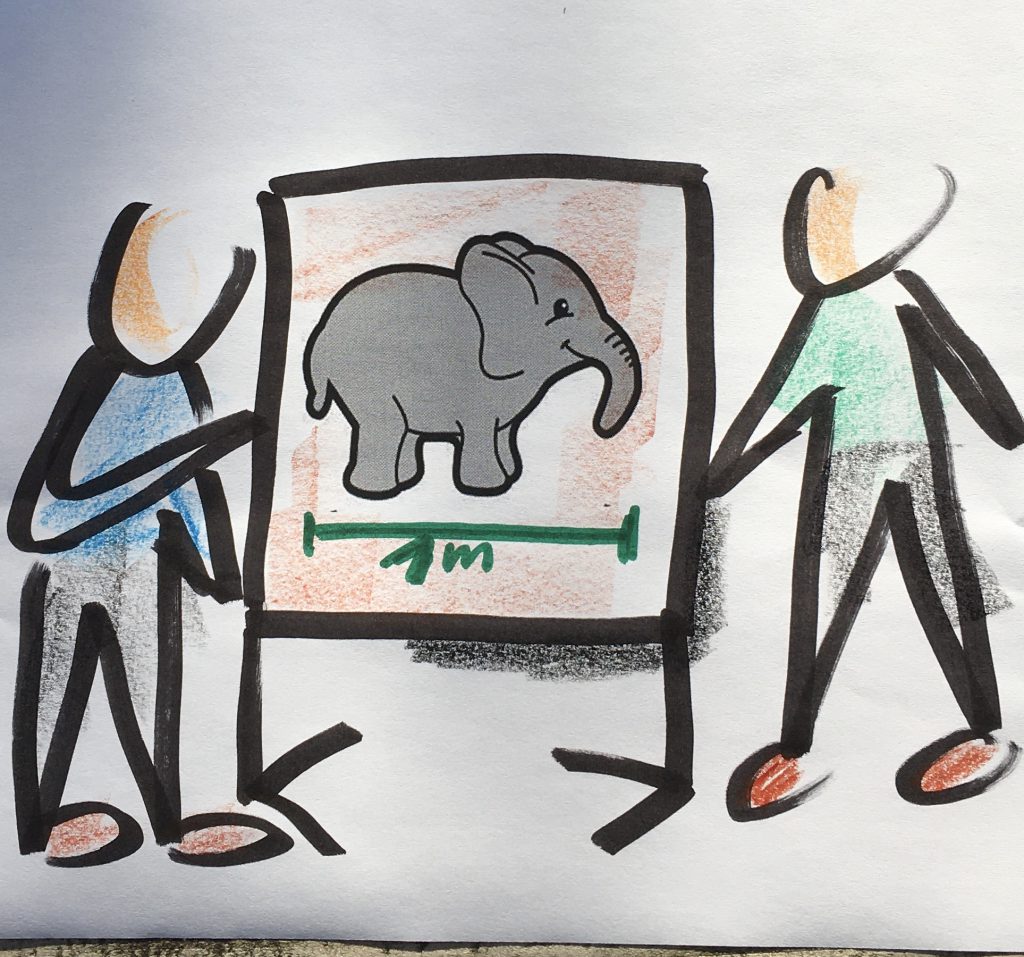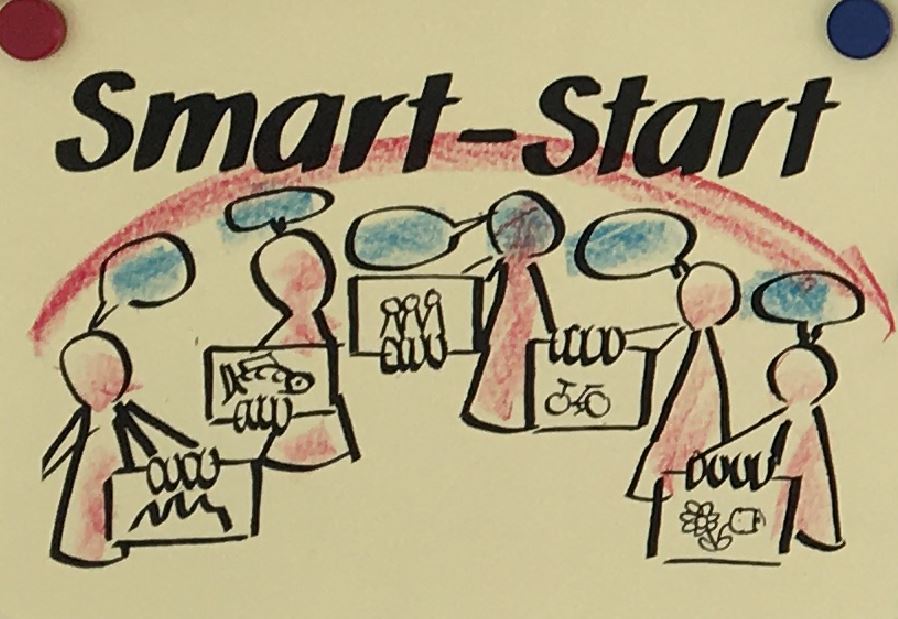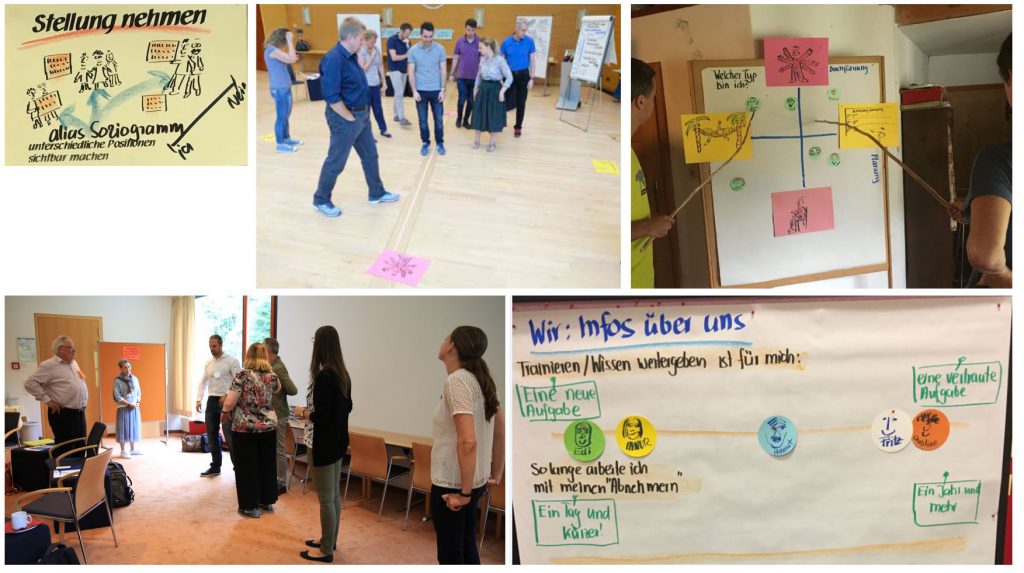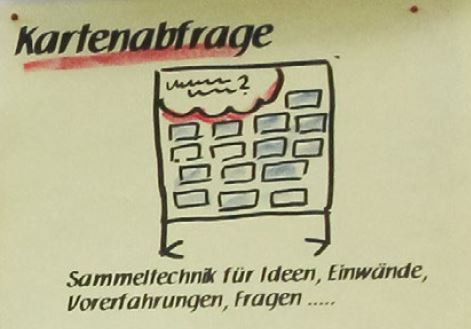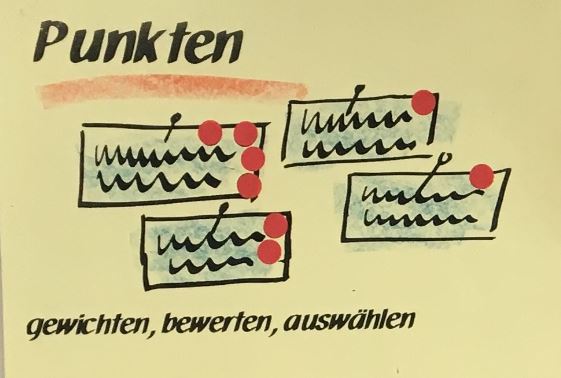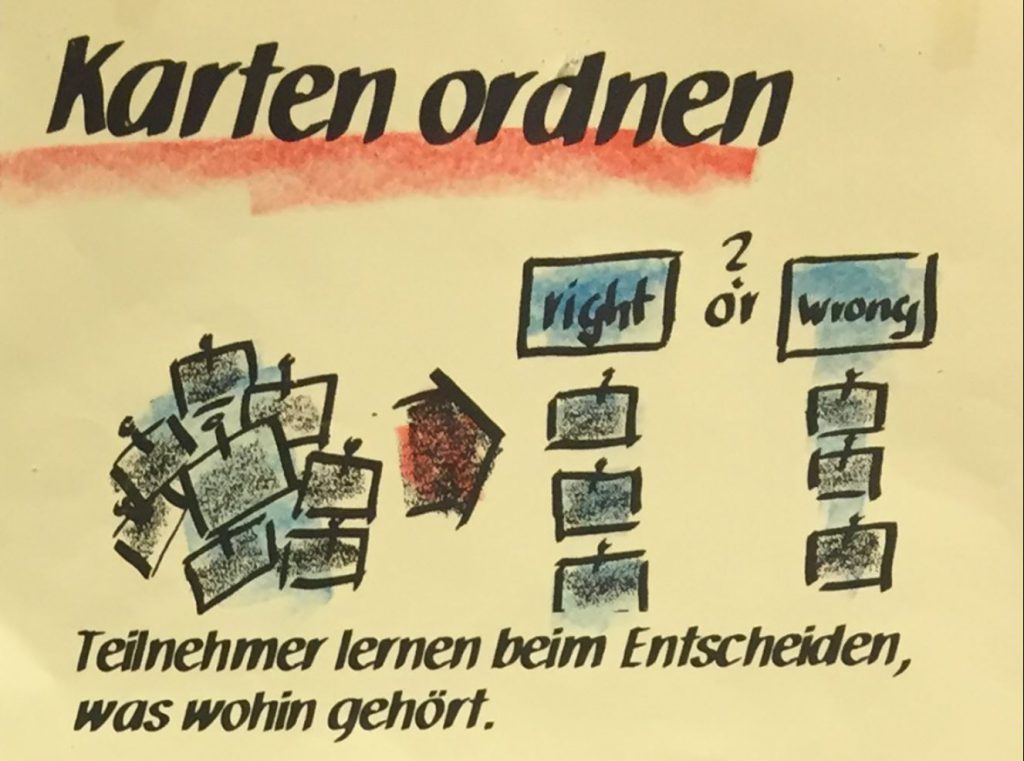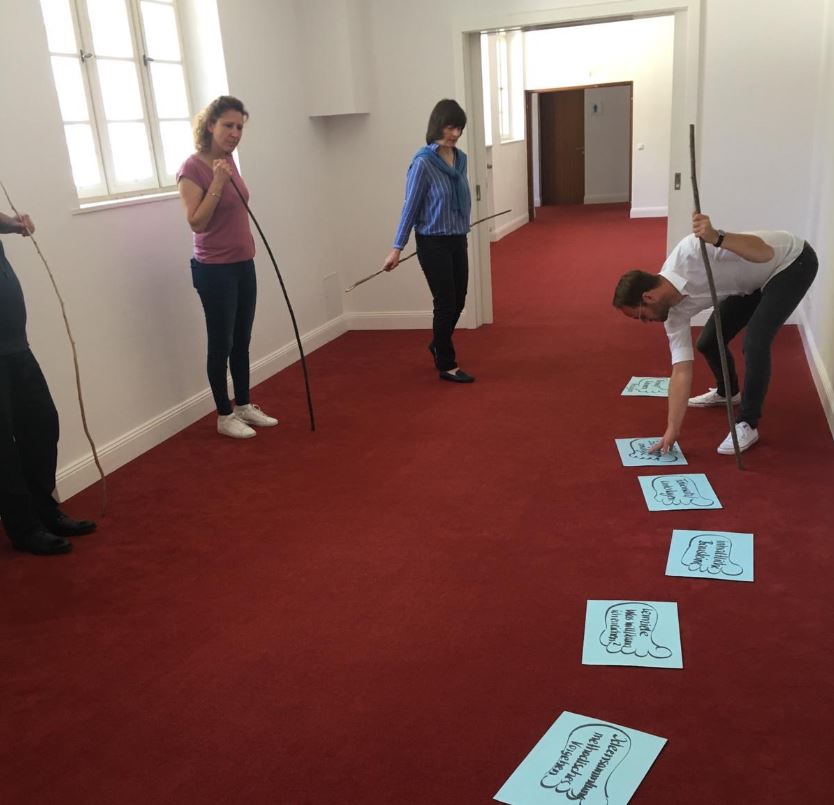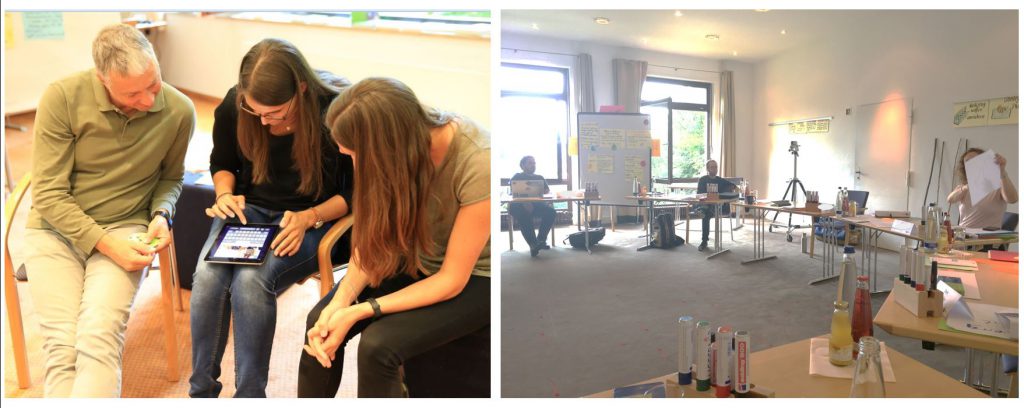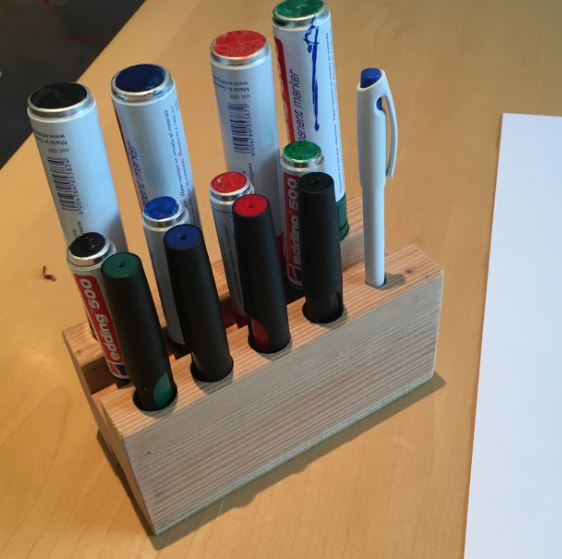Classroom training is starting up again. Now, methods are needed in which we don’t get too close to each other and in which the risk of infection is also minimized in other ways. There is much more to it than just a frontal lecture. Diversity of methods and especially the activation of the participants are also important in times of a pandemic! Here are our experiences after practical tests.
How big is a baby elephant?
The virus is the same, the required distances for face-to-face trainings are different. In Austria it is 1 meter or the unit „baby elephant“, in Germany 1.5 meters. This is also true for most other countries in Europe. If these minimum distances cannot be kept, the mask is mandatory. I have tried methods under „corona conditions“ in Austria and Germany.
Methods „Before“ and „Now“ under Corona conditions
Smart-Start to warm up also for groups that already know each other well:
Before: „Please take your smartphone and find a photo that says something about you. Then the participants stand close together, show each other the photo and explain very briefly what it is about. Now: Close together doesn’t work at all. Everyone stays in their place and instead of showing the photo, they describe what is on it. Evaluation: This works surprisingly well and even has the advantage that it’s not a problem at all if someone doesn’t have a smartphone with photos at hand. A fictitious photo is described in such a way that a picture is created in the listener’s mind.
List of participants:
Before: Participants come into the seminar room and are asked to fill in a table on the bulletin board with their name and, depending on the topic, experience, background and in any case information from their private life. This creates closeness and casual exchange as soon as they come in. Now: The participants go to their seats and fill out an A3 sheet with the same information, which I collect and hang on the pinboard. Evaluation: The benefit of being able to check every now and then (who is actually who?) remains, but the loosening effect and the quick contact at the beginning are lost.
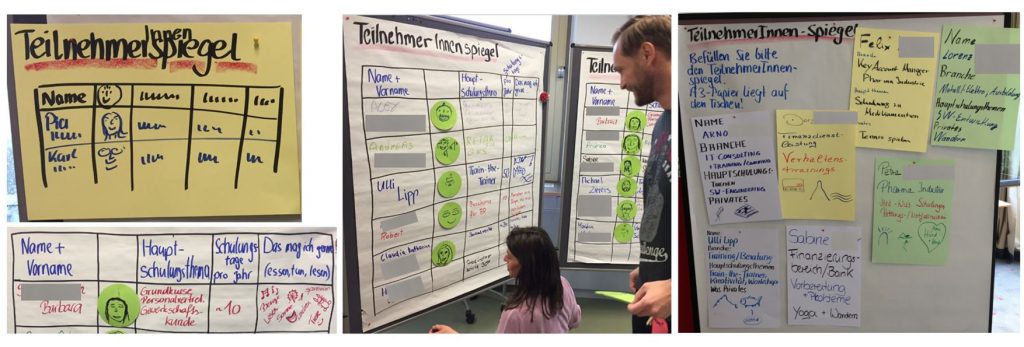
Taking a stand/lineups not only at the start:
Before: Participants line up on a mostly imaginary line between two poles (for example, much and little experience). Or: Statements are distributed around the room: Please get up and stand by the statement that applies to you! In doing so, some get very close. Now: The participants have portrayed each other before on small round cards (with distance of course). The statements and the line are visualized on the pin board. The trainer places the circles on the pinboard according to the participants‘ announcement. Evaluation: The description sounds very complicated, but the practical implementation is quite simple and even has advantages compared to the past: The pin board can be documented. For some participants, lineups are annoying. In the „Corona version“ they can remain seated. A tip: If the group is so small that they can gather around the pin board at a distance, I work with pointing sticks: I want to go right there!
Card queries to collect and collate:
Before, I had them write the cards in small groups. The participants pinned them on by themselves. There were crowds, just like during the subsequent clustering. Now the participants remain seated. Talking about the question in pairs with a neighbor is possible because they sit at a distance. The trainer collects the cards (possibly with a mouth guard if the distance cannot be established by sliding back with the chair) and pins them alone. The clustering is done on call. Evaluation: Works well. I miss the usual hustle and bustle and a lot of movement during the corona-appropriate card retrieval. When participants leave their seats to write on the cards together, it always becomes critical with the distances.
Scoring:
The weighting using adhesive dots on the flipchart or on the pinboard always caused movement beforehand and usually several people scored at the same time. After all, we didn’t have to get out of each other’s way. Now we do. That’s why I score for my participants on demand. Numbered cards make the process easier! Evaluation: Works without problems and much more orderly than the „wild scoring“ before. What is a pity, however, is that again a possibility for movement (standing up and going to the pin board) is omitted.
Putting cards in order:
Before, I gave participants a stack of prepared cards (usually A4 or A3) in their hands and asked them to put the cards in a sensible order. For this purpose, the group gathered around a pin board, discussed eagerly and then the cards were jointly placed on the pin board in the discussed order.
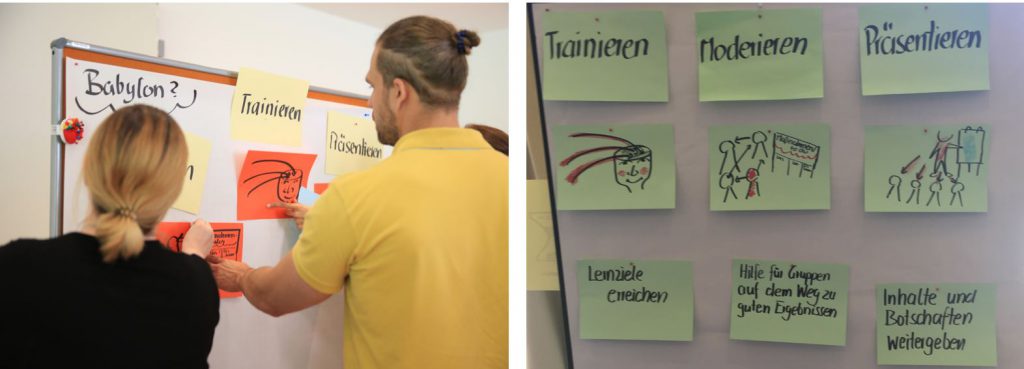
Now the participants stay in their places. I take over the task of pinning, but I only do this when prompted and without comment, even if the answers are incorrect. As in the past, the resolution takes place only when the group says: It works for us like that. I have also delegated the task of pinning and moderating the arrangement of the cards to a participant. This person must keep a distance from the group and disinfect his or her hands before and after the session.
Methods that can be used without change
There are methods that can be used without change, even in Corona times. Brainstorming on a flipchart, mind-mapping on demand, the flashlight provided nothing is being passed on, hand signaling or guessing questions, storytelling, these are all tools that avoid contagion because participants do not have to leave their fixed place. Puzzles, quizzes, and questioning methods that run on a participant’s smartphone and projector are just as safe as individual work in documents. The statement „Now only frontal speech is possible!“ is therefore fundamentally wrong.
Can I include group and partner work in Corona times?
I was curious to see how group and partner work would function under Corona conditions. And that’s where I actually experienced problems. When asked to work on a task in pairs or threes while observing the spacing rules, some participants quickly fell back into old (and cherished) behavior patterns and moved closer together.
Group and partner work is also possible at a distance. The tables where two people normally sit next to each other, I use for work in pairs so that the two participants sit at the ends or diagonally. Then the distance is there in any case. Three tables pushed together to form a block also allow work to be done at a distance in a group of three or four. Outdoor tables are great, of course, because the distance can be easily maintained and ventilation is also ensured.
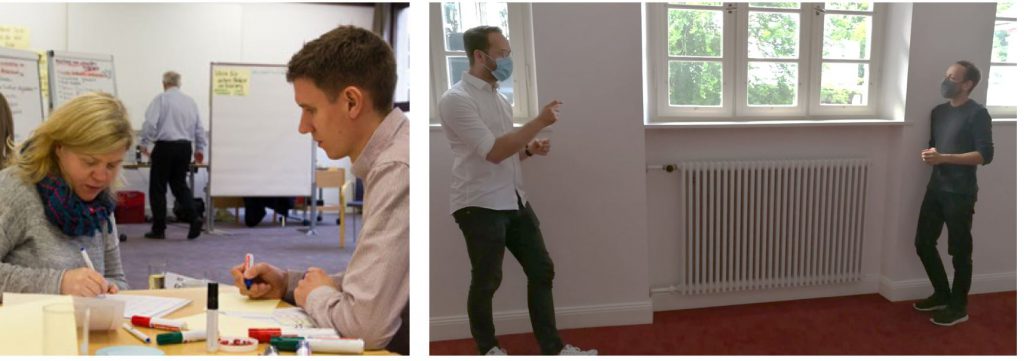
Especially in group and partner work, the distance must be discussed again and again and preferably is even written in the instructions!
Materials and space
From an email with a brief Corona report to me: „….Only the organization of many a course with 16 and more participants causes major problems. …. The large rooms at our plant are very scarce. Besides, I am not alone with the problem, there are many who need large rooms…“ After all, no one could have expected that suddenly there would have to be a distance of 1 or even 1.5 meters between the participants‘ seats. My luck with my presence seminars so far was that I had only smaller groups of participants up to 10 people. Single tables set up in a loose U have proven their worth. (See also the article Learning with distance!) But this requires space! I do not use circles of chairs at all, because the chairs „wander“ too much towards each other. Many participants are happy to do without the circle of chairs, as it is one of the more annoying methods anyway.
The unrestricted use of the moderation case is taboo. Participants receive their own pens at the beginning, freshly wiped with disinfectant wipes, and always use only these. The janitor at a certain conference center has cut a block of wood for the pens for each participant. This creates order on the tables. I often put the cards on the tables with the pens, because it is difficult to hand them out at a distance of 1.5 meters.
Well-proven: A dispenser with disinfectant and disinfectant wipes, preferably near the door and above all freely accessible and prominently placed.
For my first classroom training „afterwards“, granddaughter Sara, who after her own school experiences at a distance had curiously asked, gave me 1.5 meter long and cleanly debarked sticks: „So that they can see how much 1.5 meters is!“ The sticks were indeed used, mainly as pointing sticks at a distance: „That’s where I want my glue dot or map.“ In addition, the sticks were a constant reminder: 1.5 meters is more than you think, after all!
The corona-guard function
Guard functions in workshops and seminars are nothing new. In addition, I have introduced Corona guards who change daily and who intervene immediately when someone becomes careless. Example situation: A participant says: „Ulli, please take a picture of me with my cell phone with this flipchart poster!“ I’m already walking toward her, when a loud „Stop!“ immediately comes from the Corona guard. This guard function worked better than expected, especially because the participants took it seriously.
The participants‘ attitude is what counts!
Methodically, lively training with many active phases is also possible in times of pandemic. The practical test has confirmed this. However, it will and can only work if the participants bring the right attitude with them. This means a positive attitude toward infection control and the determination to deal with each other in a way that minimizes the risk of infection. So far, I have always had very responsible participants who kept their distance during breaks, meals and before and after the training.
Our responsibility as instructors also includes setting an example in terms of behavior, repeatedly addressing the issue of infection control and intervening if participants get too close to each other.
Author: Ulli Lipp
Lust auf mehr? Zu allen Einträgen der Serie #mm kommst du HIER!

Dieses Werk ist lizenziert unter einer Creative Commons Namensnennung-NichtKommerziell-Weitergabe unter gleichen Bedingungen unter gleichen Bedingungen 3.0 Österreich Lizenz.
Volltext der Lizenz

Dieses Werk ist lizenziert unter einer Creative Commons Namensnennung-NichtKommerziell-Weitergabe unter gleichen Bedingungen unter gleichen Bedingungen 3.0 Österreich Lizenz.
Volltext der Lizenz

